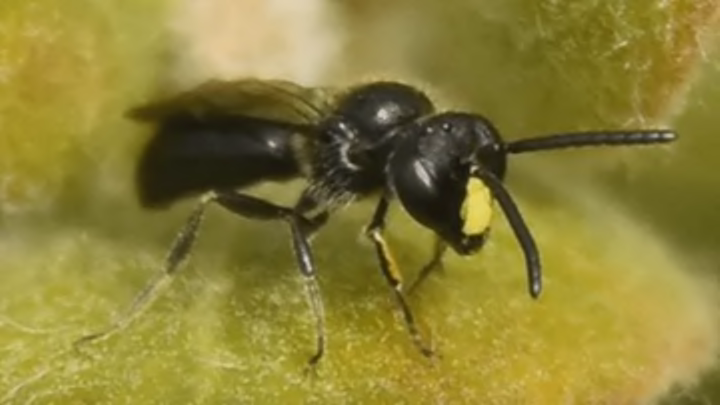The U.S. Fish and Wildlife Service (USFWS) is shining a spotlight on threatened bee populations. Last week, USFWS suggested the rusty patched bumble bee belonged on the endangered species list. This week, it officially added seven species of Hawaiian yellow-faced bees to the list [PDF]. The ruling, which will go into effect October 31, re-classifies the bees, three other animals (the band-rumped storm-petrel, the orangeblack Hawaiian damselfly, and the anchialine pool shrimp), and 39 plant species.
Hawaiian yellow-faced bees (genus Hylaeus) aren't as well-known as their bumble bee cousins or honeybees, but their story is no less incredible. A single bee traveled to Hawaii, found a local, and mated. Their offspring multiplied and spread across the islands, settling into niches in lush forests, volcanic slopes, high deserts, and white-sand beaches. Today, there are no fewer than 63 native Hylaeus species living in the islands. Naturalist R.C.L. Perkins called [PDF] the yellow-faced bees “almost the most ubiquitous of any Hawaiian insects.”
But their glory days were numbered. Human development began to chip away at the bees’ habitats and food supply, while invasive species like ants and flies carried disease and began competing for resources. Nine of the original 63 species have not been spotted in 80 years and may be extinct. Others have vanished from their original habitats, corralled into fast-shrinking safe areas. Among those are the seven newly designated endangered species: Hylaeus anthracinus, H. assimulans, H. facilis, H. hilaris, H. kuakea, H. longiceps, and H. mana.
While it might not sound like it, endangered species status is actually good news in this case. The bees and their classmates were already endangered; official designation is a step that makes it easier to protect them. Mary Abrams is USFWS supervisor for the Pacific Islands office. “Listing these species as endangered will help draw attention to the threats that have brought them so close to extinction, and allow us to begin the process of bringing about recovery,” she said in a press statement [PDF].
The designation is a good start, says Matthew Shepherd, communications director for the Xerces Society for Invertebrate Conservation. Still, he writes on the society’s blog, “there is much work that needs to be done to ensure that Hawaii’s bees thrive.” Habitat loss is a major threat, but the USFWS did not call out any areas of the islands as “critical habitat,” a label that would ensure additional protection.
Abrams emphasized that the designation was just the beginning, adding, “We will continue working with local communities, governments, industry, and the people of Hawaii to protect and recover these native species, which are an important part of what makes these islands so special.”
Know of something you think we should cover? Email us at tips@mentalfloss.com.
